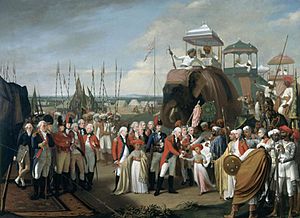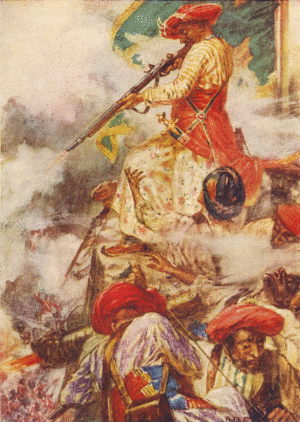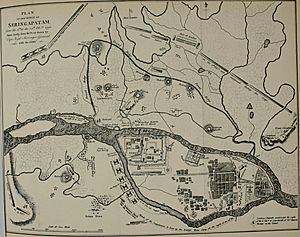Siege of Seringapatam (1792) facts for kids
Quick facts for kids Siege of Srirangapatana |
|||||||
|---|---|---|---|---|---|---|---|
| Part of the Third Anglo-Mysore War | |||||||
 General Lord Cornwallis receiving Tipoo Sultan's sons as hostages, by Robert Home, c. 1793 |
|||||||
|
|||||||
| Belligerents | |||||||
| Commanders and leaders | |||||||
The 1792 Siege of Seringapatam was an important battle. It happened at the end of the Third Anglo-Mysore War. This war was fought in India. The city of Seringapatam (now Srirangapatna) was the capital of the Kingdom of Mysore.
An army led by Charles, Earl Cornwallis attacked the city. This army included soldiers from the British East India Company and the British Army. They also had help from their allies, the Maratha Empire and the Nizam of Hyderabad.
They reached Seringapatam on February 5, 1792. After less than three weeks of fighting, they forced Tipu Sultan to give up. Tipu Sultan was the ruler of Mysore. The war ended when he signed the Treaty of Seringapatam on March 18, 1792.
Contents
Why the Siege Happened: The Background
Things were not going well for Tipu Sultan, the ruler of the Kingdom of Mysore, in 1791. He was fighting in the Third Anglo-Mysore War. He had managed to stop some advances by the British East India Company in 1790. But by 1791, he was losing ground everywhere.
Tipu Sultan used a "slash-and-burn" tactic. This meant destroying crops and supplies. He did this to stop the British army from getting food. This tactic prevented the British forces, led by Charles Cornwallis, from attacking his capital, Seringapatam.
Cornwallis's army was very low on supplies. So, he went back to Bangalore in May 1791 to get more food and wait for the rainy season to end. Tipu Sultan took advantage of this. He recaptured Coimbatore. But he lost other important places like Nundydroog and Savendroog later in 1791. Also, Britain's allies, the Nizam of Hyderabad and the Maratha Empire, took some of his land.
British Forces Prepare for Battle
In January 1792, Cornwallis gathered his army at Savendroog. It had about 20,000 British soldiers. There were also many cavalry (horse soldiers) from the Nizam of Hyderabad. A huge group of civilians also followed the army.
The army left Savendroog on January 25. They marched towards Seringapatam. Tipu's cavalry bothered them a little, but not much. On February 5, their first group reached about 7 miles (11 km) north of Seringapatam. Cornwallis set up his position there. From this spot, he could look at Tipu's defenses. When the British arrived, Tipu fired rockets at them. It was a show of power, but it didn't do much damage. These rockets might have inspired William Congreve to create the famous Congreve rockets later.
Besides this main army, Cornwallis had ordered General Robert Abercromby to bring another army. This supporting army had about 6,000 men. They were coming from the Malabar Coast (western coast).
Tipu Sultan's Strong Defenses

The city of Seringapatam was on an island in the Kaveri River. The river flows from west to east. The main city was in the middle of the island. On the western side was a strong stone fort. On the eastern side was a large walled garden. This garden had Tipu's palace and his father's tomb.
Tipu Sultan had placed his army, which Cornwallis thought was 40,000 to 50,000 strong, along the northern bank of the Kaveri River. This line was about three to four miles (four to five km) long. It had six small forts called redoubts. Much of the line was also protected by a thick hedge. On the eastern side, the line was connected to Karigaut Hill. All these defenses were set up so that the fort or other positions on the island could fire at attackers.
On February 6, Cornwallis looked at the city's defenses. He decided to attack even though Abercromby's army had not arrived yet. He wanted to attack while Tipu's army was still outside the city. If Tipu's army stayed outside, they could interfere with Abercromby's arrival. Abercromby would have to cross the Kaveri River, which was hard even without enemies nearby.
Cornwallis planned a night attack with three parts. General Medows would lead seven groups of soldiers on the right. His job was to push Tipu's left side back towards the fort. Lieutenant Colonel Maxwell would lead four groups to take Karigaut Hill on the left. Cornwallis himself would lead eight groups in the center. Their goal was to reach the river near the eastern part of the fort.
If the plan worked, Tipu's soldiers would be forced onto the island. Then, Cornwallis or Maxwell could follow them. They would set up a strong position to attack the fort. Since it was a night battle, they couldn't use cannons. So, Cornwallis ordered his soldiers to attack only with muskets and bayonets. Cornwallis did not include the Nizam's forces in the attack because he didn't trust them to fight well.
The Battle Begins
Cornwallis told his officers the details of the plan only one hour before the attack. Around 9 PM, the three groups of soldiers left their camp. In the center, Cornwallis's force reached the hedge around 11 PM. By then, they could hear gunshots from their left. This meant Maxwell's men had already started attacking Karigaut Hill. The sounds caused some confusion among Tipu's soldiers in the center.
Cornwallis ordered his men through the hedge. The British soldiers fought Tipu's men with bayonets. Tipu's soldiers ran away in a panic. They left behind their cannons, tents, and supplies. One small fort (redoubt) fought back, but it was captured. Maxwell's and Cornwallis's men chased the fleeing soldiers. They crossed the bridges onto the island and tried to get into the fort.
Tipu Sultan watched this disaster from inside the fort. He then raised the drawbridge. This stopped British soldiers, who were mixed in with his own men, from entering the fort. This kept him safe, but it left many of his soldiers trapped outside.
General Medows's group did not do as well as the other two. Medows went too far to the west in the dark. He did capture the westernmost redoubt of Tipu's line. But he couldn't get close to the island because of deep ditches and swampy ground. This created a gap between the British center and right sides. Cornwallis, who was with only one group of soldiers, was in danger. Tipu tried to use this gap to get back his camp. He launched an attack against the gap. Cornwallis managed to gather his men and push back the attack. During this fight, a bullet grazed his hand.
When daylight came, everyone could see the battlefield more clearly. Tipu ordered his cannons to start firing at the British positions. Cornwallis's men were very exposed. So, he moved his command back to Karigaut Hill. He left part of his camp behind. He also left a small group of men in the captured redoubt. This allowed Tipu's cavalry (horse soldiers) to move freely in the area. Tipu's cannons kept firing at the exposed British positions. Cornwallis could not help the men in the redoubt. He had to watch as Tipu's soldiers tried five times to storm the redoubt. All their attacks were pushed back. When night fell, Cornwallis was able to move forward and help the tired men in the redoubt. Tipu also used the night to move all his men from the north side of the Kaveri River. This allowed Cornwallis to completely surround the fort.
The Siege Continues
To make sure Abercromby's army arrived quickly, Cornwallis sent cavalry from Hyderabad and Maratha to meet them. On February 10, Abercromby's force arrived at the camp. Tipu Sultan himself led an attack to try and stop them, but he failed. From this point, the siege became a regular process. The British lines slowly moved closer to the fortress on the island. On February 23, Cornwallis checked the first trench they had dug. On the same day, Tipu sent people to talk about ending the fighting.
Peace is Made
Even though the fighting stopped on February 24, peace was not officially agreed upon until March 18. On that day, Tipu Sultan agreed to the very harsh terms of the Treaty of Seringapatam. Cornwallis first demanded that Tipu give two of his sons as hostages. This was to make sure Tipu would follow the treaty.
On February 26, Tipu's sons, aged seven and eleven, were handed over to Cornwallis. This event was captured in a famous painting by Robert Home, who was with Cornwallis.
The peace treaty forced on Tipu was very tough. Mysore's size was cut in half. The British East India Company, the Nizam, and the Marathas all shared the land. The British chose land that would make it easier to defend against future attacks from Mysore. However, the final war with Mysore was started by the British. They expected Tipu to fight again. In that war, Seringapatam was attacked, and Tipu died defending it.


